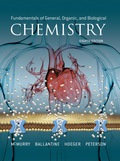
Concept explainers
(a)
Interpretation:
The reduction transformation should be draw and identified given the starting molecule of
Concept Introduction:
Reduction reaction: This reaction involves the gaining of electrons by one of the atoms involved in the reaction, for example carbonyl compounds are reduced to primary alcohols and
Carbonyl group reduction process: These processes occur by formation of a bond to the carbonyl carbon atom by a hydride ion (H+) to the carbonyl oxygen atom.
(a)
Interpretation:
In which aldehyde or ketone might be reduced to yield the fallowing alcohols was founded it should be draw and identified.
Concept Introduction:
Reduction reaction: This reaction involves the gaining of electrons by one of the atoms involved in the reaction, for example carbonyl compounds are reduced to primary alcohols and ketones are reduced to secondary alcohols.
Carbonyl group reduction process: These processes occur by formation of a bond to the carbonyl carbon atom by a hydride ion (H+) to the carbonyl oxygen atom.
(c)
Interpretation:
In which aldehyde or ketone might be reduced to yield the fallowing alcohols was founded it should be draw and identified.
Concept Introduction:
Reduction reaction: This reaction involves the gaining of electrons by one of the atoms involved in the reaction, for example carbonyl compounds are reduced to primary alcohols and ketones are reduced to secondary alcohols.
Carbonyl group reduction process: These processes occur by formation of a bond to the carbonyl carbon atom by a hydride ion (H+) to the carbonyl oxygen atom.
Want to see the full answer?
Check out a sample textbook solution
Chapter 15 Solutions
EBK FUNDAMENTALS OF GENERAL, ORGANIC, A
- Which type of enzyme catalyses the following reaction? oxidoreductase, transferase, hydrolase, lyase, isomerase, or ligase.arrow_forward+NH+ CO₂ +P H₂N + ATP H₂N NH₂ +ADParrow_forwardWhich type of enzyme catalyses the following reaction? oxidoreductase, transferase, hydrolase, lyase, isomerase, or ligase.arrow_forward
- Which features of the curves in Figure 30-2 indicates that the enzyme is not consumed in the overall reaction? ES is lower in energy that E + S and EP is lower in energy than E + P. What does this tell you about the stability of ES versus E + S and EP versus E + P.arrow_forwardLooking at the figure 30-5 what intermolecular forces are present between the substrate and the enzyme and the substrate and cofactors.arrow_forwardprovide short answers to the followings Urgent!arrow_forward
- Pyruvate is accepted into the TCA cycle by a “feeder” reaction using the pyruvatedehydrogenase complex, resulting in acetyl-CoA and CO2. Provide a full mechanismfor this reaction utilizing the TPP cofactor. Include the roles of all cofactors.arrow_forwardB- Vitamins are converted readily into important metabolic cofactors. Deficiency inany one of them has serious side effects. a. The disease beriberi results from a vitamin B 1 (Thiamine) deficiency and ischaracterized by cardiac and neurological symptoms. One key diagnostic forthis disease is an increased level of pyruvate and α-ketoglutarate in thebloodstream. How does this vitamin deficiency lead to increased serumlevels of these factors? b. What would you expect the effect on the TCA intermediates for a patientsuffering from vitamin B 5 deficiency? c. What would you expect the effect on the TCA intermediates for a patientsuffering from vitamin B 2 /B 3 deficiency?arrow_forwardDraw the Krebs Cycle and show the entry points for the amino acids Alanine,Glutamic Acid, Asparagine, and Valine into the Krebs Cycle - (Draw the Mechanism). How many rounds of Krebs will be required to waste all Carbons of Glutamic Acidas CO2?arrow_forward
 Anatomy & PhysiologyBiologyISBN:9781938168130Author:Kelly A. Young, James A. Wise, Peter DeSaix, Dean H. Kruse, Brandon Poe, Eddie Johnson, Jody E. Johnson, Oksana Korol, J. Gordon Betts, Mark WomblePublisher:OpenStax College
Anatomy & PhysiologyBiologyISBN:9781938168130Author:Kelly A. Young, James A. Wise, Peter DeSaix, Dean H. Kruse, Brandon Poe, Eddie Johnson, Jody E. Johnson, Oksana Korol, J. Gordon Betts, Mark WomblePublisher:OpenStax College Biology Today and Tomorrow without Physiology (Mi...BiologyISBN:9781305117396Author:Cecie Starr, Christine Evers, Lisa StarrPublisher:Cengage Learning
Biology Today and Tomorrow without Physiology (Mi...BiologyISBN:9781305117396Author:Cecie Starr, Christine Evers, Lisa StarrPublisher:Cengage Learning Human Biology (MindTap Course List)BiologyISBN:9781305112100Author:Cecie Starr, Beverly McMillanPublisher:Cengage Learning
Human Biology (MindTap Course List)BiologyISBN:9781305112100Author:Cecie Starr, Beverly McMillanPublisher:Cengage Learning





